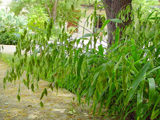Native Plants

Q. Who is Mr. Smarty Plants?
A: There are those who suspect Wildflower Center volunteers are the culpable and capable culprits. Yet, others think staff members play some, albeit small, role. You can torture us with your plant questions, but we will never reveal the Green Guru's secret identity.
Did you know you can access the Native Plant Information Network with your web-enabled smartphone?
Ask Mr. Smarty Plants is a free service provided by the staff and volunteers at the Lady Bird Johnson Wildflower Center.

rate this answer
Tuesday - May 25, 2010
From: Lovettsville, VA
Region: Mid-Atlantic
Topic: Wildlife Gardens
Title: Plants for bird garden in Virginia
Answered by: Nan Hampton
QUESTION:
I am expanding on a bird attracting garden and would like to know what plants to plant. It is a shade to partial sun area, in an approx. 9' circle, both small shrubs and flowers would be nice.ANSWER:
Here are some plants native to Virginia that attract birds and do well in shade or part shade.
Herbaceous Plants:
Aquilegia canadensis (red columbine)
Asclepias tuberosa (butterfly milkweed)
Comptonia peregrina (sweet fern)
Lobelia cardinalis (cardinalflower)
Capsicum annuum var. glabriusculum (cayenne pepper)
Small Shrubs:
Symphoricarpos orbiculatus (coralberry)
Arctostaphylos uva-ursi (kinnikinnick)
Ceanothus herbaceus (Jersey tea)
Sedges and Grasses :
Carex cherokeensis (Cherokee sedge)
Carex pensylvanica (Pennsylvania sedge)
Chasmanthium latifolium (Inland sea oats)
Elymus canadensis (Canada wildrye)
You can visit our Virginia Recommended species page to see more possibilities.
Here are photos of the plants above from our Image Gallery:
More Wildlife Gardens Questions
Host plants for Painted Lady Butterflies (Vanessa cardui)
August 22, 2009 - I am looking for host plants for the Painted Lady Butterfly that I can plant in my school's (I am a teacher) native plant/butterfly garden. As part of the curriculum, each Fall our 2nd graders study ...
view the full question and answer
Looking for grasses for slope around retention pond in Florida
August 02, 2011 - I live in St. Petersburg, FL on a large retention pond. Most of my neighbors on the pond have seawalls. I do not nor do my neighbors to my left and right. I am interested in colorful grasses to put...
view the full question and answer
Bee-pasture recommendations for AR
November 30, 2011 - Hello, I live in Melbourne, Ar, up in the NE corner of the state. I keep bees and would like to put in a couple acres of something for them. I'm leaning towards Viper's Bugloss. Do you know where I ...
view the full question and answer
Native landscaping and wildlife gardening in Clifton, TX
November 29, 2004 - I am moving to Clifton, TX, and I will have an empty lot in the town along with my own home/lot. What kind of soil can I expect? I want to grow a wildflower site to just sit and enjoy and feed the a...
view the full question and answer
Native plants to attract butterflies
October 18, 2007 - I'm a Texas A&M Wildlife and Ecology student working with a landowner in Bastrop County, Texas. As part of their Habitat Management Plan, they are hoping to enhance butterfly habitat on their proper...
view the full question and answer
| Support the Wildflower Center by Donating Online or Becoming a Member today. |

